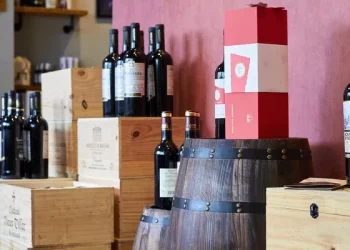Merlot is a popular red wine variety that is known for its soft, fruity, and velvety taste. It is a grape variety that is used in many Bordeaux wines, and is also commonly found as a single varietal wine. Merlot has a moderate tannin level and a flavor profile that ranges from red fruit, such as cherries and raspberries, to chocolate and coffee notes. Merlot is an excellent wine to drink on its own, as well as to pair with a variety of dishes, including grilled meats, stews, and hearty pasta dishes. Understanding the winemaking process is crucial for creating an excellent batch of Merlot. In this article, we will take a detailed look at the different steps involved in making Merlot wine.
Choosing and Harvesting Merlot Grapes:
- Types of Merlot Grapes: Merlot grapes come in many different varieties, each with its unique characteristics. Some of the most popular Merlot grape varieties include Merlot Noir, Merlot Gris, and Merlot Blanc.
- Choosing the Right Grape: The right type of grape will depend on the desired flavor and style of the wine. Merlot Noir is the most commonly used grape for making Merlot wine, and it is known for its soft tannins and fruity flavor profile. Merlot Gris and Blanc grapes are less common, but they can add a unique flavor and aroma to the wine.
- Harvesting Techniques: Harvesting Merlot grapes at the right time is crucial for creating a high-quality wine. The grapes should be harvested when they are fully ripe, which is usually in late September or early October. The grapes should be picked by hand or with a machine, depending on the size of the vineyard. The grapes should be transported to the winery as quickly as possible to prevent them from spoiling.
Crushing and Fermenting Merlot Grapes:
- Crushing Methods: There are several methods for crushing Merlot grapes, including using a mechanical crusher, stomping the grapes by foot, or using a wine press. The method used will depend on the winemaker’s preference and the desired flavor profile of the wine.
- Fermentation Process: Once the grapes are crushed, yeast is added to initiate the fermentation process. The yeast will consume the sugar in the grapes and convert it into alcohol. The temperature and sugar levels must be monitored and managed during fermentation to ensure that the wine develops the desired flavor profile.
- Temperature and Sugar Management: The temperature of the fermentation process should be kept between 68°F and 86°F, with a target temperature of 77°F. The sugar levels should be monitored regularly to ensure that the fermentation process is progressing as planned. If the sugar levels drop too quickly, additional sugar may need to be added to the wine.
Pressing and Aging Merlot Wine:
- Pressing Process: After fermentation is complete, the wine is pressed to separate the liquid from the skins, seeds, and stems. The wine can then be transferred to oak barrels or stainless steel tanks for aging.
- Aging Benefits: Aging Merlot wine in oak barrels can add additional flavors and aromas, such as vanilla and spice, to the wine. Stainless steel tanks are often used for aging white wines or for wines that are meant to be consumed young. The length of time that the wine is aged will depend on the desired flavor profile of the wine.
- Monitoring and Tasting: The aging process should be monitored regularly, and the wine should be tasted periodically to determine when it is ready to be bottled. The wine should be tasted for its aroma, color, and flavor profile.
Bottling and Labeling Merlot Wine:
- Bottling Process: Once the wine has aged to the desired flavor profile, it is time to bottle the wine. The wine is typically transferred to a clean, sterilized bottle and corked tightly to prevent any air from entering the bottle.
- Labeling Process: The labeling process includes adding important information to the bottle, such as the type of wine, vintage, and winery. It is essential to follow the laws and regulations of the country where the wine is being sold, as these laws can vary depending on the region.
- Storing Merlot Wine: Once bottled, the wine should be stored in a cool, dark place, away from sunlight and heat. The ideal temperature for storing Merlot wine is between 50°F and 59°F. The wine should be stored horizontally to keep the cork moist and prevent any air from entering the bottle.
Pairing and Serving Merlot Wine:
- Flavor Profile and Food Pairings: Merlot wine has a soft, fruity flavor profile that pairs well with a variety of dishes. It is an excellent wine to pair with grilled meats, such as steak or lamb, as well as stews and hearty pasta dishes. The wine also pairs well with cheese, such as Brie or Camembert.
- Serving Temperature: Merlot wine should be served at a temperature between 60°F and 65°F. This temperature will allow the wine to release its full aroma and flavor profile.
- Enjoyment Tips: To fully enjoy a glass of Merlot wine, it is best to decant the wine before serving. This process will help to aerate the wine and bring out its full flavor profile. It is also essential to serve the wine in the appropriate glass, such as a Bordeaux or Burgundy glass.
In conclusion, creating a high-quality batch of Merlot wine requires an understanding of the winemaking process. From choosing the right type of grape to monitoring the fermentation process, each step plays a crucial role in creating a wine with a desired flavor profile. By following the proper techniques for crushing, fermenting, pressing, and aging Merlot wine, winemakers can create a wine that is both delicious and enjoyable.
Recommended Readings:












































